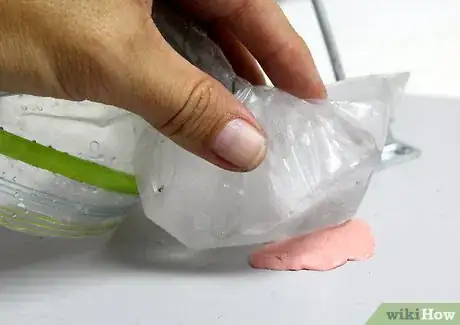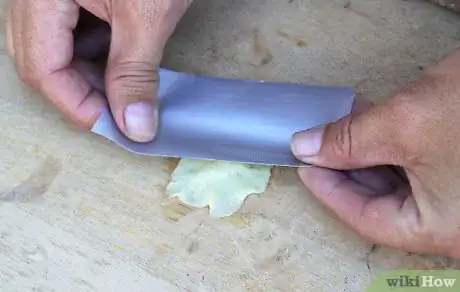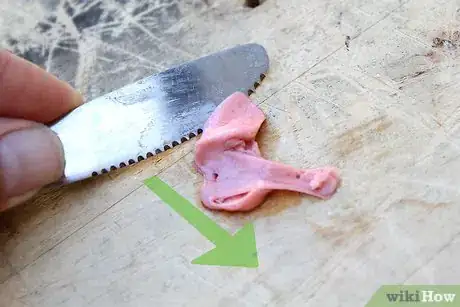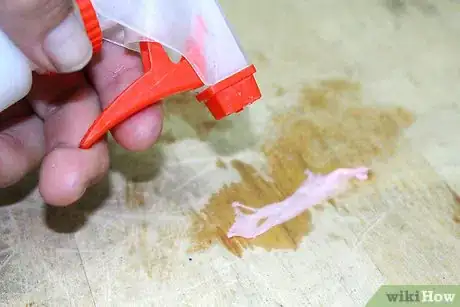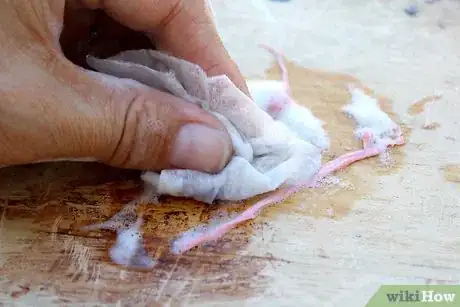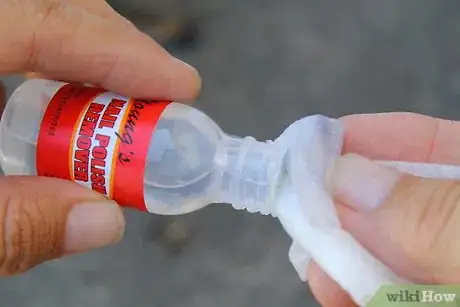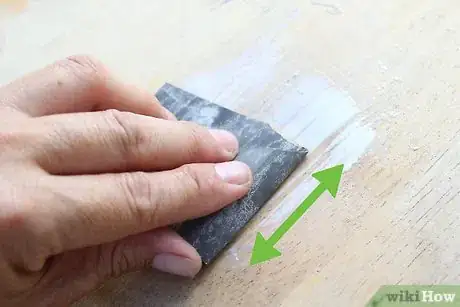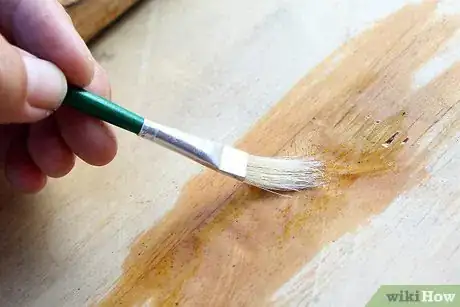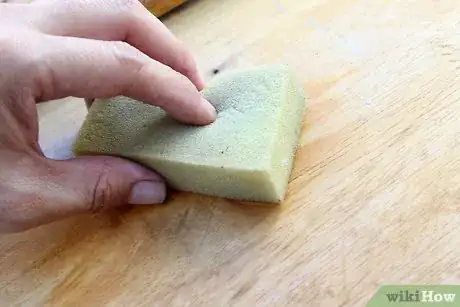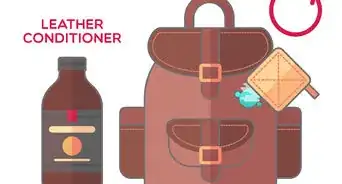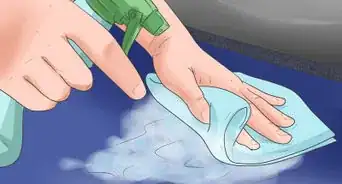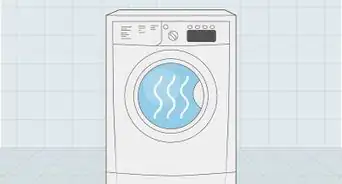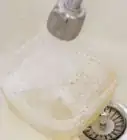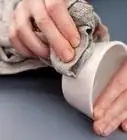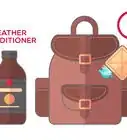This article was co-authored by Raymond Chiu. Raymond Chiu is the Director of Operations for MaidSailors.com, a residential and commercial cleaning service based in New York City that provides home and office cleaning services at affordable prices. He has a Bachelors in Business Administration and Management from Baruch College.
This article has been viewed 147,100 times.
Removing gum from a table can seem like a daunting task, but it doesn't have to be. With a few simple steps, you can remove gum, including the gum's sticky residue. Once the gum is removed, buff the table's surface to restore its shine.
Steps
Removing the Gum
-
1Apply ice cubes. Put a dozen ice cubes into a plastic bag, and hold the ice against the gummed surface. Keep it there for as long as needed to completely chill the gum.[1]
- Ice cubes will freeze the gum into a more solid element.
- Once the gum is chilled or frozen, you'll be able to remove the gum by chipping it off the table with a dull knife.
EXPERT TIPFor an alternative trick, try spraying the gum with compressed air to freeze it.
Raymond Chiu is the Director of Operations for MaidSailors.com, a residential and commercial cleaning service based in New York City that provides home and office cleaning services at affordable prices. He has a Bachelors in Business Administration and Management from Baruch College.
Raymond Chiu
House Cleaning Professional Raymond Chiu
Raymond Chiu
House Cleaning Professional -
2Rub with vegetable oil. Soak the corner of a paper towel in vegetable oil, then press it against the gummed table. Rub the area vigorously. The gum should release from the table.[2]
- Any kind of vegetable oil will work for this method.
- A light, unscented oil such as canola will leave less of a residue.
Advertisement -
3Use duct tape. To use this method, tear off a short section of duct tape. Lay the duct tape on the affected surface, sticky side down. Press the tape to the table, then lift it off.
- The gum should stick to the duct tape and lift off.
- If there's still any gum on your table, repeat this method until the gum is removed.
-
4Dab with peanut butter. Put a small amount of peanut butter on, and let it sit for 15 minutes. Follow by scraping it off with a butter knife.
- The oil in the peanut butter will help to dissolve the chewing gum and release it from the table.
- If you don't have peanut butter, try another oily substance such as mayonnaise, facial moisturizer or make-up remover wipes.
-
5Scrape gum off using a blade. Press the blade between the gum and the table's surface. Push the blade gently across the table, being careful not to press down. Pressing down could scratch the table.[3]
- A dull edge, such as a butter knife, should be used. Sharper blades should be used with caution, as they could cut you or scratch the table.
- Try putting a little vegetable oil on the blade to aid in removal.
Dissolving the Gum's Residue
-
1Apply chemical cleaner. Soak a rag or paper towel with the cleaner, and press to the gum residue left on the table. Allow to soak for 3-5 minutes. Follow by wiping with a clean, dry towel.
- Goo Gone is a good example of a chemical cleaner that effectively removes gum residue from table surfaces.
- Repeat this process as needed until all residue is removed.
-
2Rub with warm, soapy water. Fill a small container with warm water and a few drops of gentle dish washing liquid. Dampen a soft cloth or a sturdy paper towel with the soapy liquid, and apply to the gummy residue.[4]
- Be careful not to use too much soap for this process.
- If there is still residue, wash again. Rinse and dry when finished.
-
3Swab the surface with acetone. Dampen a cotton ball with acetone, or paint remover. Gently rub the wet cotton against the gummy residue.[5]
- Because this is paint remover, this method is not recommended for varnished, painted, or finished surfaces.
- Repeat until residue is no longer visible.
Repairing Wooden Table Surfaces
-
1Use a wood filler. Put wood filler onto any scratches or holes that might result from removing gum. Smooth it out with a putty knife until it feels smooth to the touch.
- Drying on a small area may take a few hours.
- Allow the filler to dry completely.
- Choose a wood filler that is paintable/stainable.
-
2Sand the area. With a fine grain sandpaper or an orbital sander, rub the area until it's very smooth. If you sand it, and it's still not smooth, reapply wood filler and sand again.
- If the surface will be visible, be careful to limit your sanding strokes.
- Once your surface is sanded smooth, you may paint or stain if desired.
-
3Apply a wood oil. If the surface needs only light repair, a wood oil may be sufficient. Generously apply the wood oil to the affected surface with a brush. Allow to soak in for 30 minutes, then rub off excess with a soft cloth.[6]
- Applying the oil along the wood grain will work best.
- Tung oil is good for tables on which food may be prepared, as it's non-toxic. For outside tables, Danish oil or teak oil is recommended.
-
4Polish well. Furniture polish may be used following application of oil. After table has been allowed to thoroughly dry, spray a soft cloth with furniture polish. Spread liberally across the table's surface.[7]
- Furniture wax may also be used. It requires more effort to apply, but results in a more stable surface.
- Furniture spray contains silicone, and will have a brighter finish than either wax or polish. Buff well to bring out the most shine.
Warnings
- Wear gloves when using chemicals or oils on your table to avoid negative skin reactions.⧼thumbs_response⧽
References
- ↑ http://www.doityourself.com/stry/how-to-remove-chewing-gum-from-wood-floors
- ↑ http://jezebel.com/5850613/how-to-get-gum-out-of-your-hair-and-everything-else
- ↑ http://www.doityourself.com/stry/how-to-remove-chewing-gum-from-wood-floors
- ↑ https://www.cleanipedia.com/gb/odour-stain-removal/how-to-remove-chewing-gum-from-carpets-other-surfaces
- ↑ http://spotremoval.coit.com/how-to-remove-glue-from-wood
- ↑ http://www.diynetwork.com/how-to/skills-and-know-how/painting/how-to-apply-stain-varnish-wax-dye-or-oil-to-wood
- ↑ http://www.hgtv.com/design/decorating/clean-and-organize/caring-for-furniture
About This Article
You can remove gum from your table in just a few simple steps with some common household items. Put a dozen ice cubes into a plastic bag and hold it on the gummed surface until it’s chilled. Once the gum is frozen solid, chip it off the table with a dull knife. Alternatively, try soaking the corner of a paper towel in vegetable oil, then rubbing it into the gummed area until it releases. You can also try tearing off a piece of duct tape, pressing it down into the affected area, and lifting the gum up with the piece of tape. Another way to remove gum is to put some peanut butter on it, let it sit for 15 minutes, then scrape it off with a butter knife. After you remove the gum, wash the table with warm, soapy water to dissolve any residue. To learn how to repair your wooden table surface if it’s been scratched, keep reading!
